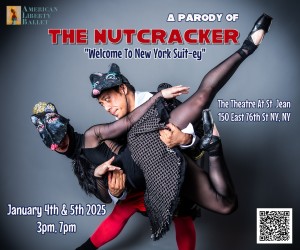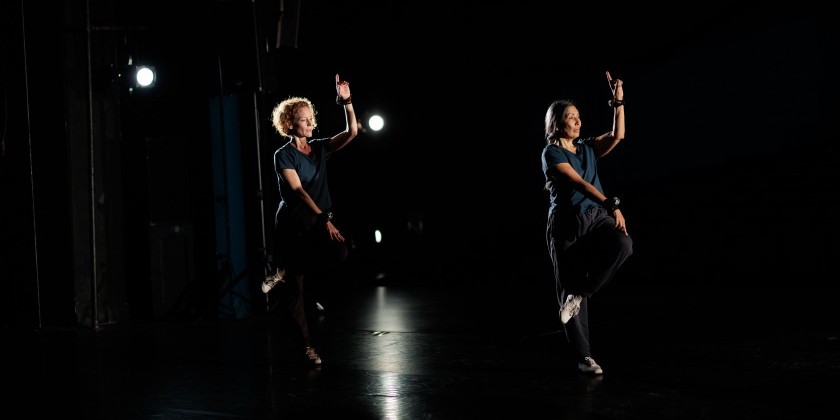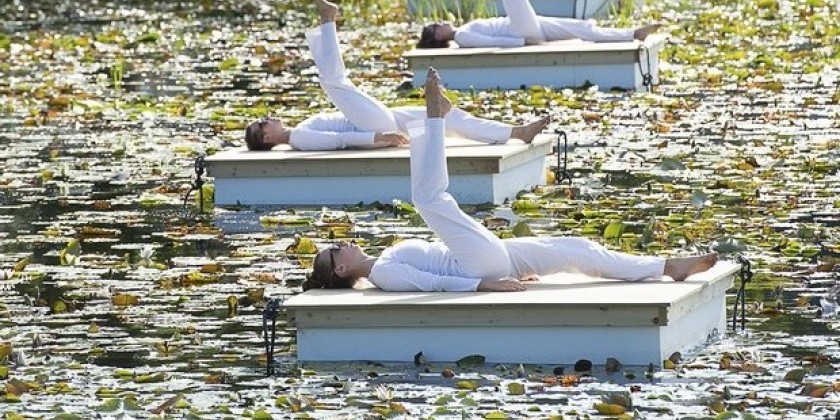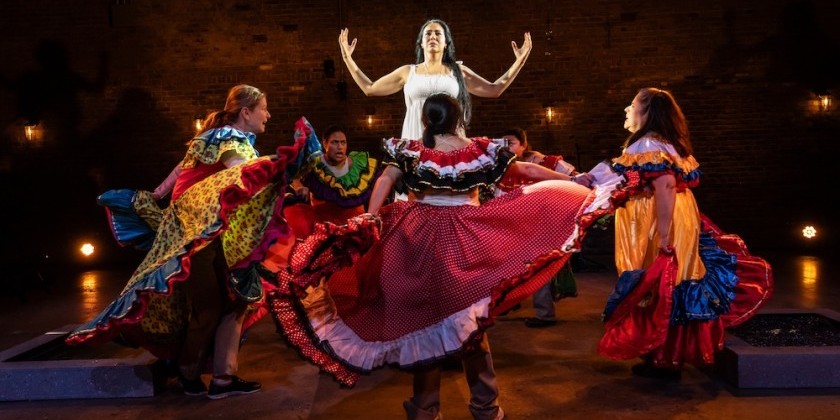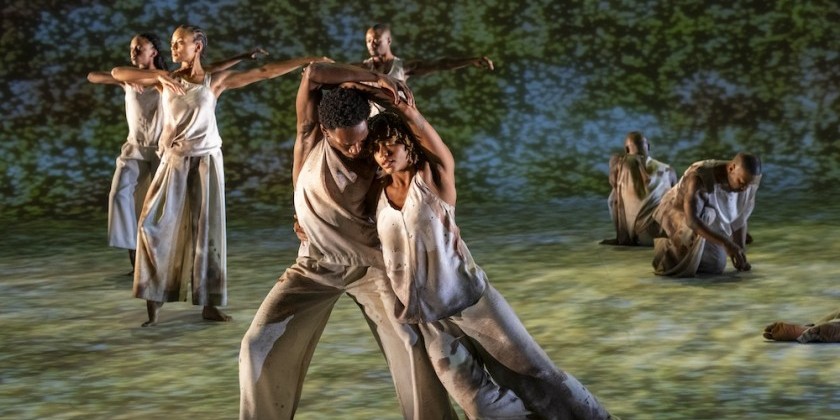IMPRESSIONS: Roderick George/kNoname Artist's "The Missing Fruit" at Kaatsbaan Cultural Park
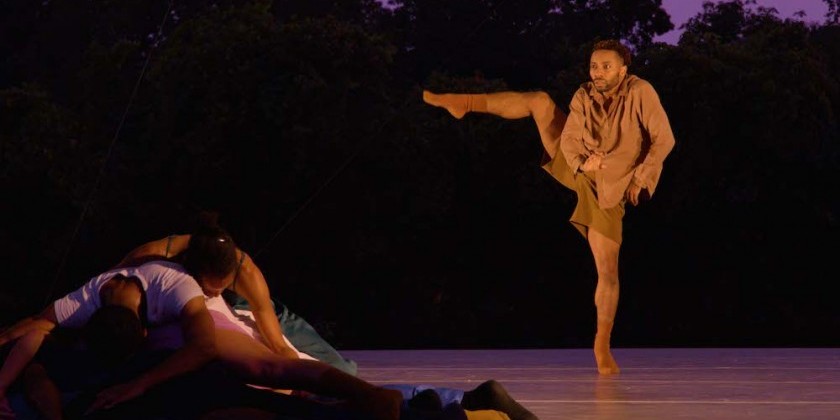
Choreography: Roderick George
Music: slowdanger | Performed by pvkvsv
Producer: Florent Trioux
Dancers: Roderick George, Alex Haskins, India Hobbs, Stella Jacobs, Nouhoum Koita, Elijah Labay, Amanda Peet, Xavier Williams
Behind Kaatsbaan Cultural Park’s idyllic Mountain Stage, the sky faded from luminous blue to a flash of deep pink-orange behind shreds of clouds, a faint half moon turning to rise as the sun dipped below a horizon of gently rolling green hills. Amid the delicate sounds of birds and crickets, I sat in a fold-out lawn chair with my feet in the lush grass, the fresh country air brisk against my summer-warmed skin, goosebumps rising against the chill. I marveled at the sensitivity of my body’s response to its environment — vigilant, defensive, resilient—and the visceral imperative of instinct rooted in my embodied nature. If my body responded so markedly to this subtle seasonal turn in the calm of an open field on a clear evening, how might it respond to trauma?
Embodied trauma response lies at the center of kNoname Artist/Roderick George’s The Missing Fruit, an evening-length dance in three parts that unflinchingly probes the repercussions of historical trauma and the persistence of oppression experienced by people of color. Inspired by the 2020 Black Lives Matter protests, The Missing Fruit is a labor of love developed over years, with multiple iterations involving the voices of a diverse array of artists. The strength of the work lies in its multivocality of perspectives and expressions, which lends depth to its clear thematic focus.

Roderick George, Alex Haskins, India Hobbs, Stella Jacobs, Nouhoum Koita, Elijah Labay, Amanda Peet and Xavier Williams in The Missing Fruit. Photo: A Doll's House Pictures
George, who dances alongside a stellar cast of seven distinctive artists, deploys an expansive movement language through nonlinear narrative to make visible the weight of shared pain and the force of collective strength. The work opens with a pounding heartbeat as the dancers emerge, rising one by one from beneath the open back of the stage (a quirk of this particular setting used to startling effect), their bodies prostrate and heavy. Clad in a palette of rich browns that complement their complexions, they begin to build a vernacular: clear lines shatter into distorted shapes, fluid floor work slithers to peak in vertiginous balances, mutually supportive partnerships loft high into the air, tracing long arcs into deep slides.
The shifting rhythms of slowdanger’s score, performed live by pvkvsv, paint a soundscape for multiple dynamics to unfold simultaneously. While the athletic virtuosity of the movement is undeniable, a subtler language materializes in gestures of protection, challenge, and uplift as bodies gather in tight clusters, graphic tableaus, and precise unisons. Each dancer is vulnerable in their search, breaking free in turn from the tension of the group, only to return to the shelter of its solidarity. Low-slung footwork, syncopated ripples, and sharp isolations lend dimension to the distortion and repetition of the house-inflected beats punctuated by soul, hip-hop, and spoken word, each element surging through waves of sonic and kinetic momentum. Hands and wrists articulate volumes in minute, isolated oscillations perched on stiffly bent knees and prickly balls of feet. An acrobatic entanglement between George and Elijah Labay ends abruptly: a gunshot, silence, and a lone body left sprawled in a corner.
From an extended, uncomfortable silence, deep droning tones rumble into a heaving pulse as the dancers emerge once again, now head to toe in funereal black, their faces obscured as anonymous silhouettes moving through slow contortions of mourning. Nouhoum Koita brings a conflicted, grieving father’s monologue to life, his expressive face exposed as he reckons with the weight of loss, regret, and responsibility in the aftermath of a senseless act of violence that cut short his son’s promising life.
The group wavers in relation to the embattled father figure, both supportive community and dogged specter as they dress the son’s lifeless body, lifting him through a funeral procession and ritualized dance. This gentle but forceful act of mourning unfolds in stark opposition to the monologue that voices the complications of race, gender, and class that contributed to perceived threat, violent reaction, and consequences both fatal and enduring. As the group carries the body away, Koita backs up slowly, one arm raised in a slow wave goodbye.
The culmination of George’s triptych deals with the larger ripple effect of collective social response to racial injustice, with a particular focus on the core energies behind large-scale protests. The murdered individual’s perception as threat parallels the projection of protest into riot, with snippets of impassioned and sensationalist political speeches tossed into a chaotic curtain of sound to heighten the sense of opposition.

Fear and exhaustion mingle in bursting sprints and lethargic slow motion, coalescing in momentary tableaus — two dancers drag an inert body by the wrists, another kneels with a hand over the heart of a still figure, checking for signs of life. Sonic distortion and grotesque caricature amplify a cascade of emotional registers: terror, frustration, injustice, aggression, menace, confrontation, despair. One by one, the exhausted dancers trace messages in the air and lay in a pile as George reanimates for a final virtuosic solo, shedding his burden to break free with loose-limbed delicacy and powerful loft — a literal and symbolic body that, while reveling in liberation, will never forget its oppression.
All told, The Missing Fruit is a courageous tour de force with a resolute social message. The work’s merit stands on its own, though lighting and scenic production elements and a keen edit will bring it to its fullest realization. The strength of George’s choreographic voice both magnifies and transcends his weighty subject matter — an apt signal of a bright and prolific future.





